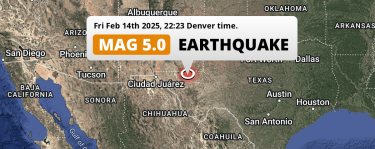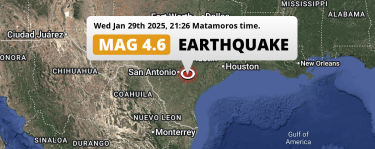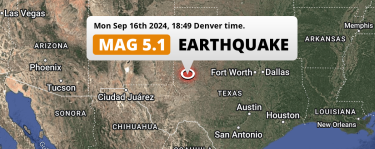Latest earthquakes near Mexico today
Complete overview of the latest earthquakes near the country Mexico, updated every minute. Did you feel an earthquake today in Mexico? If an earthquake is happening right now near Mexico, it will show up within minutes.
Recent Mexico Earthquake News
These are the latest articles published related to earthquakes occurring near Mexico. Check our Earthquake News section for a complete overview of articles written on earthquakes near Mexico and elsewhere.
Mexico Earthquake Statistics
Average
A total of 16911 earthquakes with a magnitude of four or above have struck within 300 km (186 mi) of Mexico in the past 10 years. This comes down to a yearly average of 1691 earthquakes per year, or 140 per month. On average an earthquake will hit near Mexico roughly every 5 hours.
A relatively large number of earthquakes occurred near Mexico in 2017. A total of 2226 earthquakes (mag 4+) were detected within 300 km of Mexico that year. The strongest had a 8.2 magnitude.

Magnitude Distribution
The table below visualizes the distribution of all earthquakes that occurred within 300km of Mexico in the past 10 years. No earthquakes with a magnitude of 9 or above have occurred near Mexico during this time. Usually, higher magnitudes are less common than lower magnitudes. Small earthquakes with a magnitude below 4 on the Richter scale have been omitted from this overview.
| Magnitude | Earthquakes | Percentage |
|---|---|---|
| Mag. 4 | 16499 | 97.56% |
| Mag. 5 | 374 | 2.21% |
| Mag. 6 | 32 | 0.19% |
| Mag. 7 | 5 | 0.03% |
| Mag. 8 | 1 | 0.01% |
| Mag. 9 | 0 | 0.0% |
| Mag. 10 | 0 | 0.0% |
Strongest earthquakes near Mexico
The strongest recent earthquake of the past 10 years near Mexico occurred on Sep 7, 2017 23:49 local time (America/Mexico_City timezone). It had a magnitude of 8.2 and struck 177 kilometers (110 mi) west of Tapachula, at a depth of 47 km. Discover more strong earthquakes near Mexico in the list below.
In the table below you will find the strongest earthquakes that occurred near Mexico in the past 10 years. You can use the tabs to find the heaviest historic earthquakes since the year 1900 or within a specific year or distance from Mexico.
Earthquakes by region of Mexico
Click the links below for earthquake reports for regions in Mexico.
- Aguascalientes
- Baja California
- Baja California Sur
- Campeche
- Chiapas
- Chihuahua
- Coahuila (Coahuila de Zaragoza)
- Colima
- Durango
- Guanajuato
- Guerrero
- Hidalgo
- Jalisco
- Mexico City (Ciudad de México)
- Michoacán (Michoacán de Ocampo)
- Morelos
- México
- Nayarit
- Nuevo León
- Oaxaca
- Puebla
- Querétaro (Querétaro de Arteaga)
- Quintana Roo
- San Luis Potosí
- Sinaloa
- Sonora
- Tabasco
- Tamaulipas
- Tlaxcala
- Veracruz (Veracruz-Llave)
- Yucatán
- Zacatecas
Frequently Asked Questions
These questions are commonly asked in relation to earthquakes occurring near Mexico.
When was the last earthquake in Mexico?
A 4 magnitude earthquake hit near Mexico on the morning of February 19, 2025 at 07:35 local time (America/Mexico_City). The center of this earthquake was located 44km west-southwest of Ciudad Lázaro Cárdenas at a depth of 16km under water in the North Pacific Ocean. Check the list on our website for any earthquakes occurring near Mexico in the past hours.
What was the strongest earthquake near Mexico?
A 8.2 magnitude earthquake hit near Mexico on the evening of September 7, 2017 at 23:49 local time (America/Mexico_City). The center of this earthquake was located 177km west of Tapachula at a depth of 47km under water in the North Pacific Ocean. This is the strongest earthquake that occurred near Mexico since the year 1900.
How often do earthquakes occur near Mexico?
In the past 10 years, 16911 earthquakes with a magnitude of four or higher occurred within a 300 kilometer range from Mexico. This averages to 1691 earthquakes yearly, or one earthquake every 5 hours.

 Feb 14, 2025 11:23PM
Shallow M5.0 Earthquake struck on Friday Evening near Carlsbad in The United States.
Feb 14, 2025 11:23PM
Shallow M5.0 Earthquake struck on Friday Evening near Carlsbad in The United States.
 Feb 5, 2025 01:01AM
Significant M5.6 Earthquake hit in the North Pacific Ocean 146km from Guatemala City (Guatemala) on Wednesday Night.
Feb 5, 2025 01:01AM
Significant M5.6 Earthquake hit in the North Pacific Ocean 146km from Guatemala City (Guatemala) on Wednesday Night.
 Jan 29, 2025 09:26PM
Unusually powerful M4.5 Earthquake struck on Wednesday Evening near San Antonio in The United States.
Jan 29, 2025 09:26PM
Unusually powerful M4.5 Earthquake struck on Wednesday Evening near San Antonio in The United States.
 Jan 12, 2025 02:32AM
On Sunday Night a Strong M6.2 Earthquake struck near Colima in Mexico.
Jan 12, 2025 02:32AM
On Sunday Night a Strong M6.2 Earthquake struck near Colima in Mexico.
 Jan 9, 2025 10:31AM
Significant M5.8 Earthquake hit near Sonsonate in El Salvador on Thursday Morning.
Jan 9, 2025 10:31AM
Significant M5.8 Earthquake hit near Sonsonate in El Salvador on Thursday Morning.
 Sep 16, 2024 07:49PM
On Monday Evening a Shallow M5.1 Earthquake struck near Midland in The United States.
Sep 16, 2024 07:49PM
On Monday Evening a Shallow M5.1 Earthquake struck near Midland in The United States.
